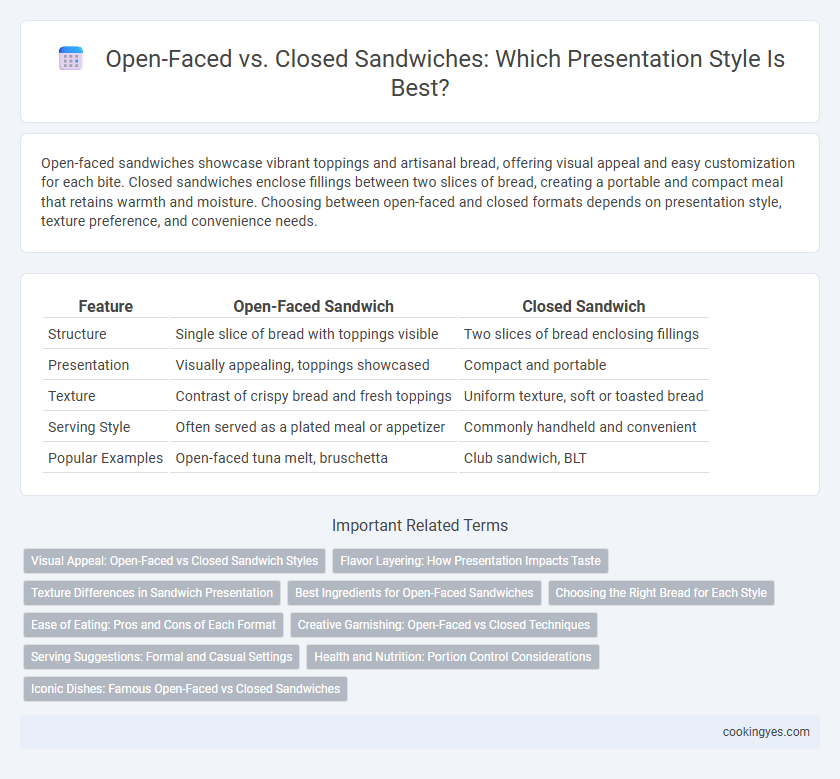Open-faced sandwiches showcase vibrant toppings and artisanal bread, offering visual appeal and easy customization for each bite. Closed sandwiches enclose fillings between two slices of bread, creating a portable and compact meal that retains warmth and moisture. Choosing between open-faced and closed formats depends on presentation style, texture preference, and convenience needs.
Table of Comparison
| Feature | Open-Faced Sandwich | Closed Sandwich |
|---|---|---|
| Structure | Single slice of bread with toppings visible | Two slices of bread enclosing fillings |
| Presentation | Visually appealing, toppings showcased | Compact and portable |
| Texture | Contrast of crispy bread and fresh toppings | Uniform texture, soft or toasted bread |
| Serving Style | Often served as a plated meal or appetizer | Commonly handheld and convenient |
| Popular Examples | Open-faced tuna melt, bruschetta | Club sandwich, BLT |
Visual Appeal: Open-Faced vs Closed Sandwich Styles
Open-faced sandwiches showcase vibrant toppings and colorful ingredients, enhancing visual appeal with a clear view of fresh vegetables, meats, and garnishes. Closed sandwiches, with layers stacked between two slices of bread, create a neat, compact look that emphasizes structure and balance. The choice between open-faced and closed styles influences presentation by highlighting either artistic ingredient display or classic, handheld convenience.
Flavor Layering: How Presentation Impacts Taste
Open-faced sandwiches showcase vibrant ingredients on top, enhancing flavor layering by allowing each component's texture and taste to stand out individually. Closed sandwiches blend fillings between two slices of bread, creating a harmonious fusion of flavors that meld together with every bite. The choice of presentation directly influences the taste experience by balancing ingredient prominence and overall flavor integration.
Texture Differences in Sandwich Presentation
Open-faced sandwiches highlight crisp, toasted bread topped with fresh ingredients that create a contrast between crunchy base and soft toppings, enhancing textural diversity. Closed sandwiches offer a uniform bite, with the bread enclosing fillings, producing a balanced chewiness and melded flavors that emphasize moist, cohesive textures. Texture differences in presentation impact mouthfeel: open-faced delivers layered crispness, while closed provides compact, integrated softness.
Best Ingredients for Open-Faced Sandwiches
Open-faced sandwiches highlight fresh, high-quality ingredients like ripe avocados, smoked salmon, soft cheeses such as cream cheese or brie, and vibrant vegetables including heirloom tomatoes and arugula. Choosing artisanal breads like sourdough or multigrain enhances texture and flavor, while toppings like fresh herbs or a drizzle of olive oil elevate the presentation. These ingredients ensure a visually appealing and flavorful open-faced sandwich that maximizes ingredient freshness and balance.
Choosing the Right Bread for Each Style
Open-faced sandwiches benefit from sturdy, thick slices like sourdough or rye that hold toppings without becoming soggy, enhancing flavor and texture. Closed sandwiches require bread varieties such as sandwich white, whole wheat, or brioche, which provide structural integrity and easy handling. Selecting bread with the right density and crumb complements each style, ensuring optimal presentation and taste.
Ease of Eating: Pros and Cons of Each Format
Open-faced sandwiches offer easy access to toppings, making each bite flavorful and customizable, but they can be messier and harder to eat on the go due to the lack of a top slice. Closed sandwiches provide a more contained and portable option, preventing ingredients from sliding out and making them less likely to drip, though they may limit taste variety in a single bite and can require more effort to hold. Choosing between open-faced and closed sandwiches depends on balancing ease of eating with the desired texture and flavor experience.
Creative Garnishing: Open-Faced vs Closed Techniques
Open-faced sandwiches offer a versatile canvas for creative garnishing, allowing vibrant toppings like fresh herbs, colorful veggies, and drizzles of sauces to remain visually striking and easily accessible. Closed sandwiches, while concealing ingredients, encourage layering techniques that enhance texture and flavor complexity without compromising portability or structural integrity. Both presentation styles benefit from strategic use of edible flowers, microgreens, and contrasting colors to elevate the overall sensory experience.
Serving Suggestions: Formal and Casual Settings
Open-faced sandwiches are ideal for formal settings where presentation and elegance matter, often garnished with fresh herbs and arranged carefully on fine china to highlight their visual appeal. Closed sandwiches suit casual environments, offering ease of handling and portability, making them perfect for picnics, lunches, and informal gatherings. Both styles can be enhanced with complementary sides like pickles or chips, tailored to the occasion's tone and guest preferences.
Health and Nutrition: Portion Control Considerations
Open-faced sandwiches typically offer better portion control due to using only one slice of bread, which reduces carbohydrate intake and overall calories compared to closed sandwiches with two slices. This single-layer structure allows for a higher ratio of nutrient-dense toppings like vegetables and lean proteins, enhancing vitamin and mineral consumption without excess starch. Choosing open-faced sandwiches can support weight management and blood sugar regulation by limiting refined grain portions while still delivering balanced nutrition.
Iconic Dishes: Famous Open-Faced vs Closed Sandwiches
Open-faced sandwiches like the classic Smorrebrod from Denmark showcase artisanal toppings on a single slice of bread, emphasizing visual appeal and flavor layering. In contrast, closed sandwiches such as the iconic Reuben or BLT provide a handheld, portable meal with ingredients enclosed between two slices of bread, ensuring a balanced bite. Both styles highlight cultural preferences and presentation methods that define their iconic status in culinary traditions.
Open-faced vs Closed for sandwich presentation Infographic

 cookingyes.com
cookingyes.com